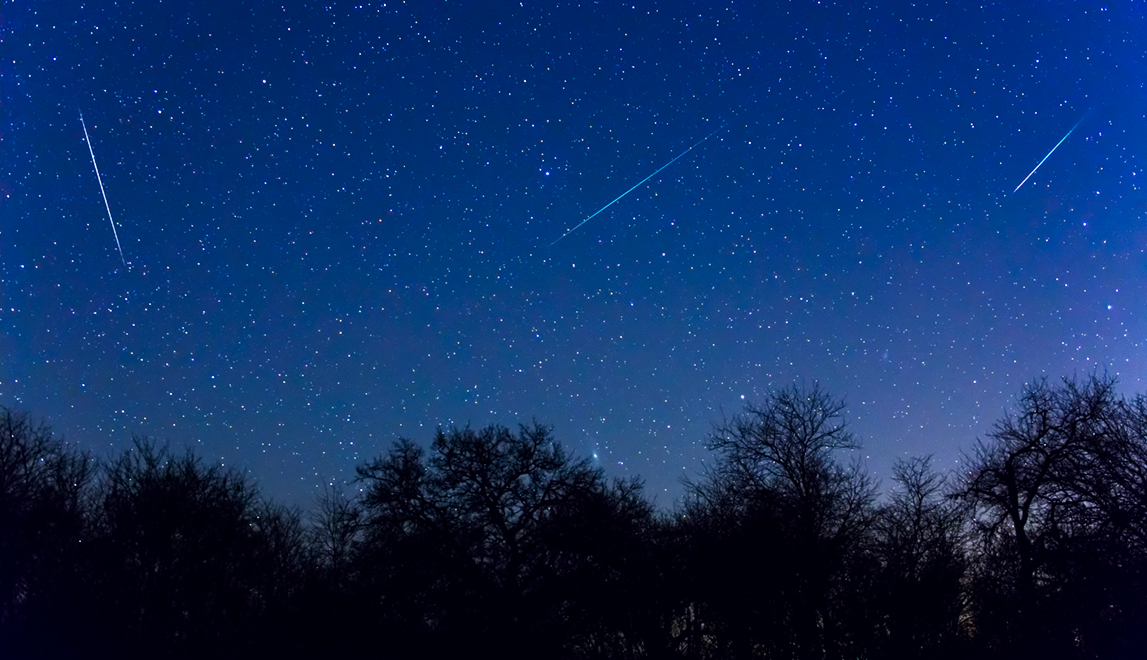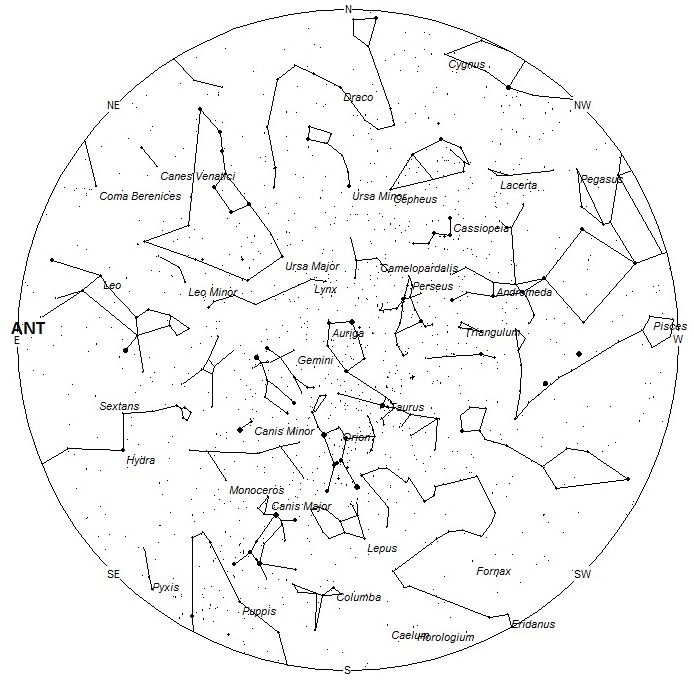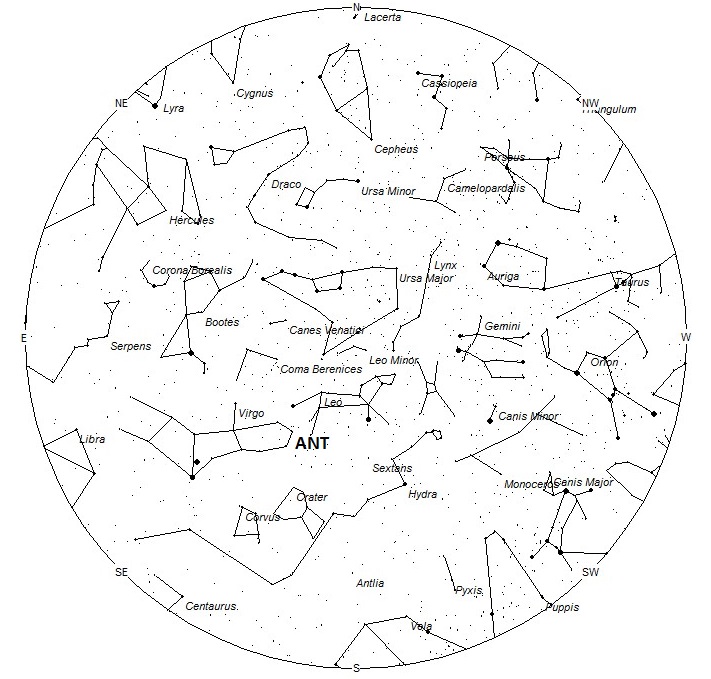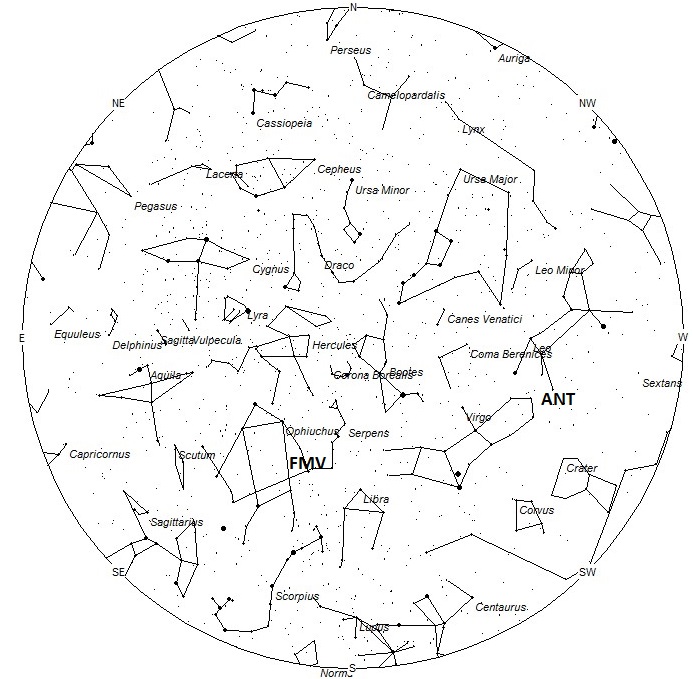
As seen from the northern hemisphere, March is the slowest month for meteor activity. No major annual showers are active and only a few very weak minor showers produce activity this month. The sporadic rates are also near their annual minimum so there is not much to look forward to this month except for the evening fireballs that seem to peak this time of year as seen from the northern hemisphere. This could be due to the fact the Antapex radiant lies highest above the horizon this time of year during the evening hours. From the southern hemisphere, activity from the Centaurid complex begins to wane with only the weak activity visible from Norma and perhaps others nearby areas. At least southern sporadic rates are still strong to make the late summer viewing a bit more pleasurable.
During this period the moon reaches its new phase on Sunday February 26. At this time the moon is located near the sun and is invisible at night. As the week progresses the waxing crescent moon will enter the evening sky but will not interfere with meteor observing. The estimated total hourly meteor rates for evening observers this week is near 3 for those viewing from the northern hemisphere and 5 for those located south of the equator. For morning observers the estimated total hourly rates should be near 7 as seen from mid-northern latitudes (45N) and 16 as seen from tropical southern locations (25S). The actual rates will also depend on factors such as personal light and motion perception, local weather conditions, alertness and experience in watching meteor activity. Note that the hourly rates listed below are estimates as viewed from dark sky sites away from urban light sources. Observers viewing from urban areas will see less activity as only the brightest meteors will be visible from such locations.
The radiant (the area of the sky where meteors appear to shoot from) positions and rates listed below are exact for Saturday night/Sunday morning February 25/26. These positions do not change greatly day to day so the listed coordinates may be used during this entire period. Most star atlases (available at science stores and planetariums) will provide maps with grid lines of the celestial coordinates so that you may find out exactly where these positions are located in the sky. A planisphere or computer planetarium program is also useful in showing the sky at any time of night on any date of the year. Activity from each radiant is best seen when it is positioned highest in the sky, either due north or south along the meridian, depending on your latitude. It must be remembered that meteor activity is rarely seen at the radiant position. Rather they shoot outwards from the radiant so it is best to center your field of view so that the radiant lies at the edge and not the center. Viewing there will allow you to easily trace the path of each meteor back to the radiant (if it is a shower member) or in another direction if it is a sporadic. Meteor activity is not seen from radiants that are located below the horizon. The positions below are listed in a west to east manner in order of right ascension (celestial longitude). The positions listed first are located further west therefore are accessible earlier in the night while those listed further down the list rise later in the night.
These sources of meteoric activity are expected to be active this week.
The center of the large Anthelion (ANT) radiant is currently located at 11:20 (170) +04. This position lies in southeastern Leo, 2 degrees south of the 4th magnitude star known as sigma Leonis. Due to the large size of this radiant, Anthelion activity may also appear from Sextans and western Virgo as well as southern Leo. This radiant is best placed near 0100 local standard time (LST), when it lies on the meridian and is located highest in the sky. Rates at this time should be near 2 per hour no matter your location. With an entry velocity of 30 km/sec., the average Anthelion meteor would be of slow velocity.
The February Mu Virginids (FMV) were discovered by Damir Šegon and colleagues from the Croatian Meteor Network using their data and that of SonotaCo. These meteors are active from February 15 through March 4 with maximum activity occurring on February 26. The current radiant position lies near 16:24 (246) -02, which actually places it western Ophiuchus, 3 degrees northeast of the pair of 3rd magnitude stars known as “Yeds” (delta and epsilon Ophiuchi). Rates, even at maximum, are expected to be less than 1 per hour no matter your location. These meteors are best seen near 0500 LST when the radiant lies highest above the horizon. At 62 km/sec. the February Mu Virginids would produce mostly swift meteors.
As seen from the mid-northern hemisphere (45N) one would expect to see approximately 5 sporadic meteors per hour during the last hour before dawn as seen from rural observing sites. Evening rates would be near 2 per hour. As seen from the tropical southern latitudes (25S), morning rates would be near 14 per hour as seen from rural observing sites and 4 per hour during the evening hours. Locations between these two extremes would see activity between the listed figures.
| SHOWER | DATE OF MAXIMUM ACTIVITY | CELESTIAL POSITION | ENTRY VELOCITY | CULMINATION | HOURLY RATE | CLASS |
| RA (RA in Deg.) DEC | Km/Sec | Local Standard Time | North-South | |||
| Anthelion (ANT) | – | 11:20 (170) +04 | 30 | 01:00 | 2 -2 | II |
| February mu Virginids (FMV) | Feb 26 | 16:24 (246) -02 | 64 | 05:00 | <1 – <1 | IV |
 American Meteor Society
American Meteor Society



I believe I saw a meteor at approximately 8:50 while passing through Sayre, OK. The meteor was bright green in color and fizzled out at the end. I am not 100 percent certain that what I saw was a meteor (flare gun was second guess), but if anyone can confirm or deny that would be very helpful!
Paige and All,
It was definitely a meteor as we have reports from several states for the same object. You can see a map of the eyewitnesses by visiting: http://www.amsmeteors.org/members/imo_view/event/2017/791
Robert Lunsford
Ok, it was a massive meteor traveling from east to west at about 20:52 CST on February 26. I was in Moore, Oklahoma driving on 19th street west bound.
I could not have been the only one to see this, most amazing thing I have ever seen. At first, I thought it was an airplane landing, then I looked to my left shoulder as it was moving faster than a plane, I then thought it was a plane on fire then I realized it was a large mass or small planet, colorful blues and greens, a meteor or debris.
I live in central Louisiana and driving home this evening at about seven thirty I saw a meteor burn across the northeastern sky. Was really bright then turned green and I could see the firey break up of the meteor as it tore across the atmosphere. Really really cool sight!!
Hello late Tuesday evening of the 28th at the Utah to colorado border close to I=70 we saw at appro9ximately 7 45 pm to 755 pm a large meteior with a green tail or ball. t was North of I-70 and the town of Loma Colorado . It was seen while we were heading northbound on the highway to rangely colorado. Did any one else see if from that antag point. it seemed to be about 20 miles further north.